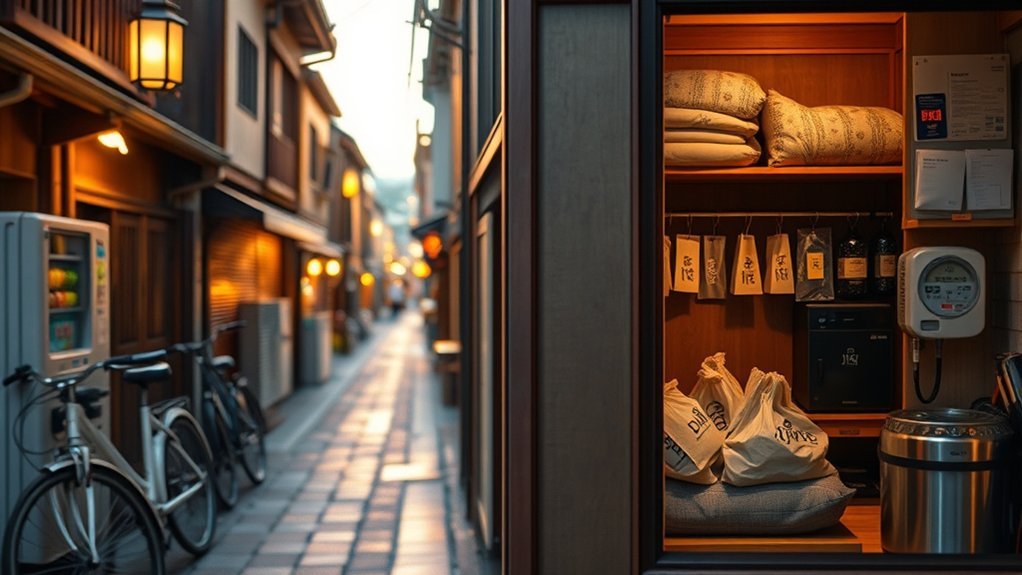You’ll typically pay ¥47,000–85,000 for a one-bedroom in Kyoto; add about ¥40,000–70,000 for utilities, food, transport and connectivity depending on lifestyle. Expect utilities around ¥13,000 (electricity ¥7,000, gas ¥3,500, water ¥2,500), internet/mobile ¥2,000–6,000, and groceries based on unit prices (rice ¥454/kg, eggs ¥333/dozen). A monthly transit pass is ~¥12,386. These benchmarks help you build a realistic budget, and the next section breaks down each line item with saving tips.
Accommodation and Rent Breakdown
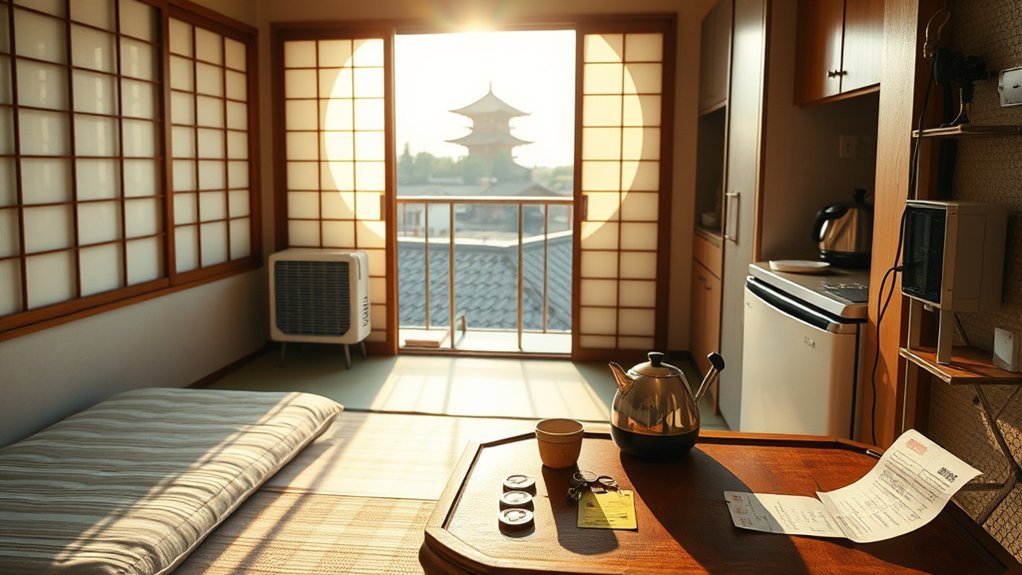
Wondering how much you’ll pay to live in Kyoto? You can expect Rent to vary sharply by location and size. In central Kyoto, a 1-bedroom lists at about 85,135 yen/month; outside the city center a comparable 1-bedroom averages 47,625 yen/month. Larger units spike: a 3-bedroom in the city center is estimated at 266,667 yen/month.
Nationwide data for 1-room apartments (20–40 m²) runs 50,000–70,000 yen/month, which aligns with lower-cost Kyoto options outside the center. Note that rent typically excludes utilities, so the figures above cover only leasing costs. You should budget rent first, then layer other monthly expenses. If you’re comparing neighborhoods, use the central 1-bedroom and 3-bedroom benchmarks to gauge premium pricing and contrast with outside-center 1-bedroom rates to find savings opportunities. This gives you a clear baseline for accommodation costs before adding monthly bills.
Utilities and Monthly Bills
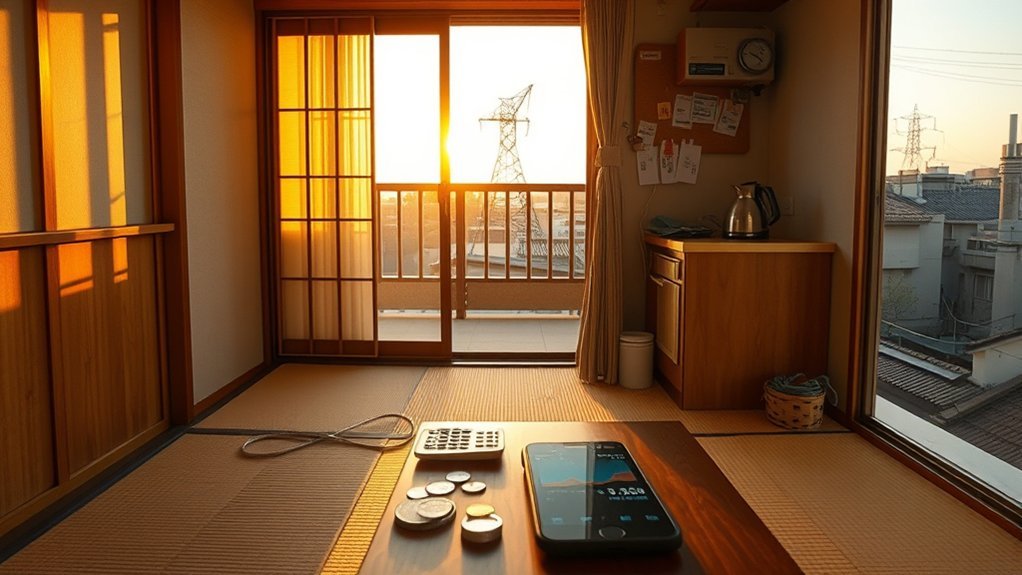
For an 85 m² apartment expect basic utilities (electricity, heating/cooling, water, garbage) to average about ¥16,156 per month, with electricity typically around ¥7,000, gas ¥3,500 and water ¥2,500. If you’re single, budget roughly ¥13,000 monthly, and note some Leopalace units or guesthouses may include utilities in the rent. Add about ¥3,000–6,000 for internet and mobile, and you can cut bills by using energy-efficient appliances, adjusting thermostat usage, and choosing bundled plans. Additionally, performing regular maintenance on appliances can help reduce overall utility costs.
Typical Monthly Utilities
How much will utilities add to your Kyoto budget each month? Utilities typically run about ¥13,000 for one person: electricity ~¥7,000, gas ~¥3,500, water ~¥2,500. Electricity is usually the largest component and varies with season and appliance use.
For larger units, documented basic utilities (electricity, heating/cooling, water, garbage) can reach ~¥16,156 monthly for an 85 m2 apartment, illustrating dwelling-size effects. Most rentals don’t include utilities, though some Leopalace units and guesthouses bundle them, lowering your out-of-pocket cost. Expect variation by consumption patterns, building insulation, and heating method. When budgeting, use ¥13,000 as a baseline per person, adjust upward for larger apartments or heavy usage, and confirm whether utilities are included before signing a lease.
Internet and Mobile Costs
Alongside electricity and water, you’ll want to budget for mobile and internet service, which typically add another ¥5,500–¥10,500 per month depending on choices. Mobile plans cost about ¥6,000 with major carriers, while discount operators drop to around ¥2,000; choose based on data needs and coverage.
For home connectivity, pocket Wi-Fi runs ~¥3,500 monthly; fiber/home broadband averages ¥4,500. Some people supplement or replace home service with paid Wi-Fi hotspots or manga-cafe access for occasional heavy use.
Setup and billing vary by residence type, and many rentals exclude utilities, so confirm responsibility upfront. You can arrange Internet plans and mobile contracts through local providers and electronics retailers like NTT, Yamada Denki, and Bic Camera for competitive offers.
Tips to Lower Bills
Wondering where you can trim monthly bills in Kyoto? You’ll see average utilities for one person near 13,000 yen (electricity 7,000; gas 3,500; water 2,500).
Use these targeted steps to lower living costs.
- Choose smaller spaces or Leopalace/guesthouse options with utilities included to cut the ~16,156.25 yen baseline for an 85 m2 apartment.
- Switch mobile to discount operators (about 2,000 yen) instead of conventional plans (~6,000 yen) to save ~4,000 yen monthly.
- Pick internet by need: pocket Wi-Fi (~3,500 yen) or fiber (~4,500 yen); match speed to usage to avoid overspending.
- Monitor electricity/gas usage and set efficient thermostats to reduce the largest utility portions.
Food, Groceries, and Eating Out
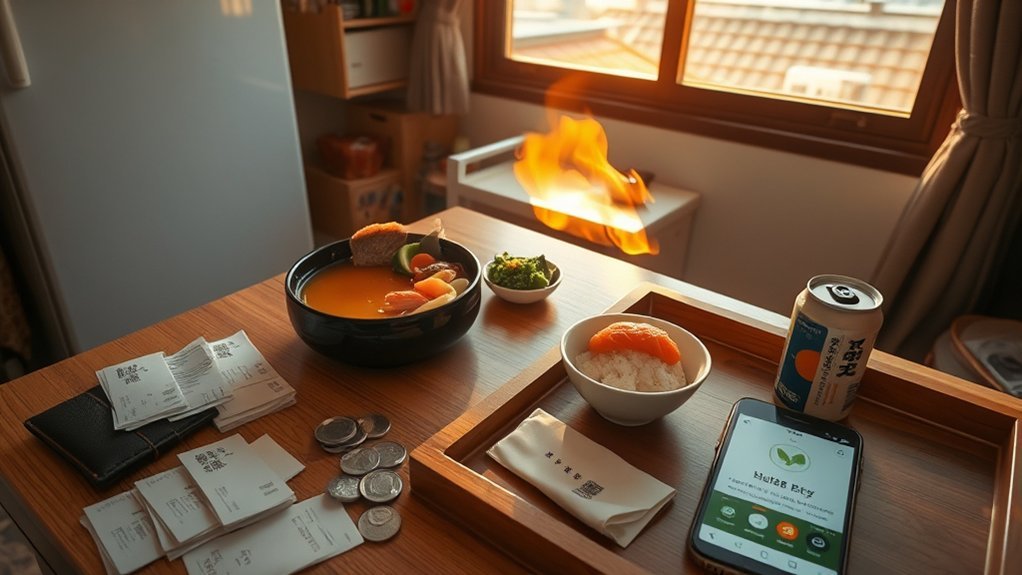
Curious what you’ll spend on food in Kyoto? You’ll find groceries reasonably priced: milk about 263.83 yen/L, a loaf of white bread 254.33 yen, eggs (12) 332.62 yen, and 1 kg white rice 454.47 yen. Chicken fillets run near 1,020 yen/kg, potatoes 233.33 yen/kg, and bottled water about 111.43 yen/L. Those figures let you model weekly staples and monthly grocery totals precisely.
Eating out spans inexpensive to mid-range: cheap meals typically 500–1,000 yen, average restaurant dishes 1,000–3,000 yen, a mid-range meal for two about 5,000 yen, a fast-food combo ~800 yen, and a domestic beer ~500 yen. Combine predictable supermarket prices with discount-period shopping and you’ll manage affordable daily food costs. Use per-item prices to build a meal plan and estimate monthly spend; balancing home-cooked meals and occasional dining out will keep your food budget efficient without sacrificing variety. Additionally, it’s helpful to consider the various factors influencing costs that can affect your overall food budget in Kyoto.
Transportation and Commuting Costs
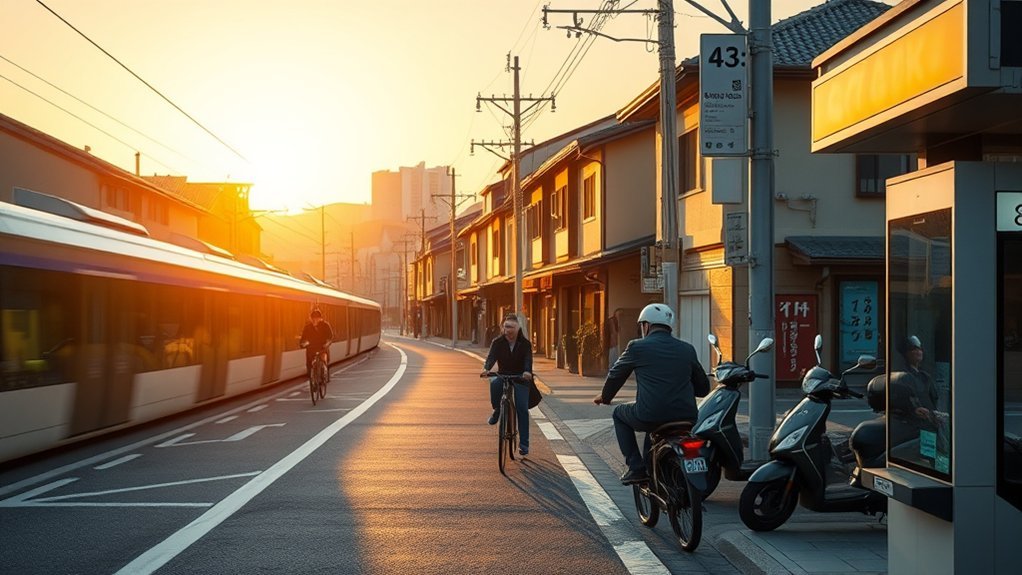
After planning groceries and dining, you’ll want to estimate daily travel costs: a single local trip costs 235 yen while a monthly commuter pass runs about 12,386.30 yen, so regular riders break even after roughly 53 one-way trips. You should compare payback against your net salary (286,250 yen) to judge affordability and set a transportation costs budget.
- Train/bus: 235 yen per trip; monthly pass (12,386.30 yen) suits commuters who ride frequently and reduces per-trip cost.
- Taxi: 500 yen starting fare; an 8 km ride averages about $28 in local terms — use sparingly for urgent trips.
- Car ownership: gasoline ~175.25 yen/L; factor fuel, parking, and maintenance into monthly estimates.
- Airport trips: the nearest airport is 39 km away; include longer fares or shuttle fees when budgeting occasional travel.
Additionally, understanding local transportation costs can help you make informed choices about your commuting budget. Use these figures to model weekly and monthly spending precisely.
Connectivity: Mobile and Internet Options
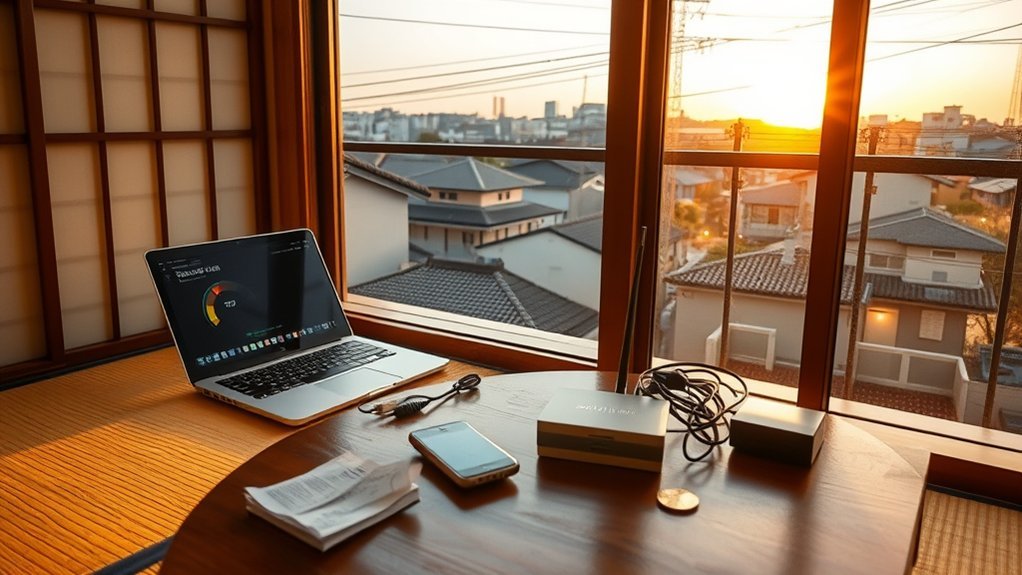
How will you stay connected in Kyoto? You’ll choose between mobile plans and home internet based on budget, residence, and documentation. Conventional mobile plans average ¥6,000/month; discount operators offer about ¥2,000/month if you have a residence card and Japanese bank account. For home internet, pocket Wi-Fi runs near ¥3,500/month; fiber/broadband averages ¥4,500/month. Some rentals include utilities and connectivity, so check your lease before subscribing.
| Option | Typical monthly cost |
|---|---|
| Conventional mobile plans | ¥6,000 |
| Discount mobile plans | ¥2,000 |
| Pocket Wi-Fi | ¥3,500 |
| Fiber/Broadband | ¥4,500 |
If you prefer flexibility, paid Wi-Fi hotspots and manga cafes offer intermittent access without installation. Installation and availability depend on building wiring and provider. Compare data caps, contract length, and roaming if you travel. Use the table and these figures to budget connectivity precisely. Additionally, understanding average expenses for utilities can help you plan your overall monthly budget more effectively.
Household Goods, Furniture, and Appliances
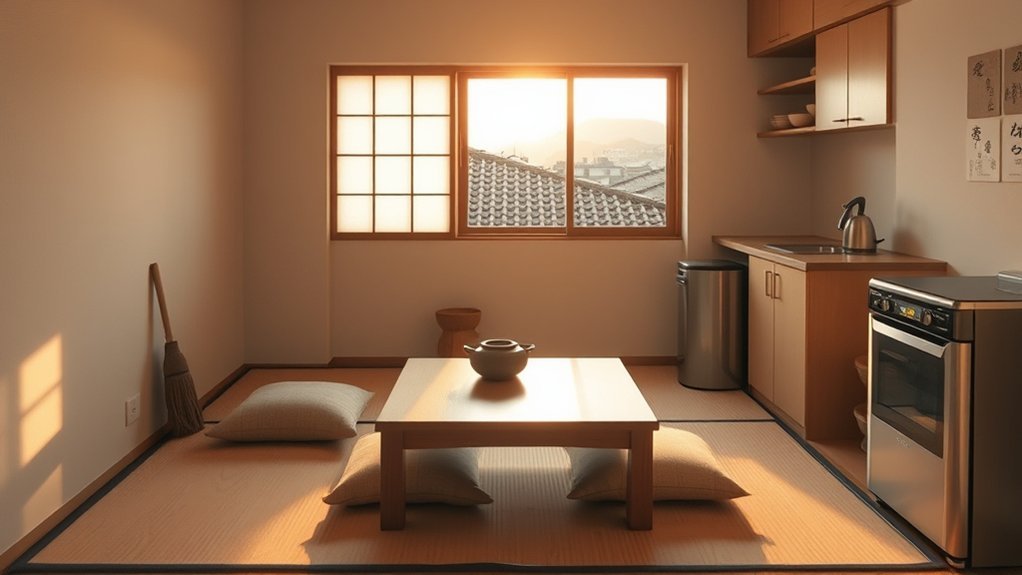
You’ll find furniture and basics across options like Ikea, Nitori, Muji and 100-yen shops, which lets you match quality to budget. Expect entry-level appliances and electronics (for example an iPad Wi-Fi 128GB at ¥48,660) alongside routine consumables—deodorant ¥744, cold medicine (6 days) ¥1,210, cigarettes ¥443/pack, tampons ¥1,901/box—when estimating setup costs. Additionally, consider the potential for DIY repairs to save on future expenses when setting up your home. Compare store prices and seasonal discounts to decide whether to buy new, budget, or mix in secondhand pieces.
Where to Buy Furniture
Where should you shop for furniture and household goods in Kyoto? You’ll balance cost of living with convenience: major chains (Nitori, Muji, Ikea) cover furniture basics and varied styles; Aeon, Ito Yokado and Bic Camera add household goods. For tight budget moves, 100 Yen Shops handle basics at ~100 yen plus tax. Online platforms (Amazon, Rakuten) expand choices with delivery to Kyoto addresses. Short-term renters often choose guesthouses or shared accommodations that include furnishing; standard rental contracts usually don’t.
- National chains: Nitori, Muji, Ikea — reliable for furniture and mattresses.
- Department/elec stores: Ito Yokado, Bic Camera, Yamada Denki — good for small items.
- 100 Yen Shops — cheapest household essentials.
- Online: Amazon, Rakuten — broad selection, home delivery.
Budget Appliances & Costs
Looking for affordable appliances and household basics in Kyoto? You’ll find options that keep your initial monthly cost impact low. Entry-level microwaves, rice cookers, and kettles at Nitori, Muji or 100-yen shops range from ¥500–¥5,000 one-time; expect mid-range fridge or washer purchases around ¥30,000–¥60,000. If you budget appliance amortization into rent planning, spreading a ¥50,000 appliance over 24 months adds roughly ¥2,100 to your monthly cost. Utilities for an 85 m² place average ¥16,156/month, so factor electricity (≈¥7,000) when choosing energy-efficient models. Use pocket Wi-Fi (¥3,500/month) or fiber (¥4,500/month) for connectivity. For low upfront spending, prioritize essential, compact appliances and buy larger items secondhand or during seasonal sales.
Health, Personal Care, and Insurance
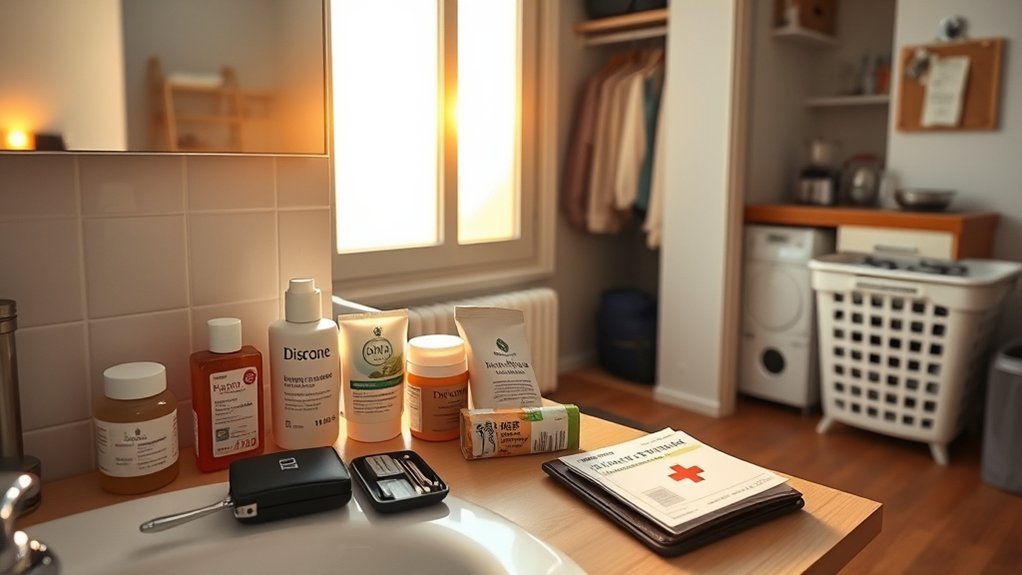
How much will basic health and personal-care items add to your monthly budget? Personal care essentials and basic health costs in Kyoto are moderate but add up: deodorant (50ml) runs about ¥744 and tampons cost ¥1,901 per box, so plan for recurring purchases. Over-the-counter cold medicine for a short course is roughly ¥1,210. If you use fitness to stay healthy, a 1-month gym membership in the business district is approximately ¥11,842, which is the largest single item here.
Factor in national health insurance premiums separately; they vary by income, so add that to this baseline when budgeting for comprehensive health coverage. It’s also wise to consider additional costs like personal care services or health consultations that may arise throughout the month.
- Deodorant (50ml): ¥744 — low recurring cost for daily hygiene.
- Tampons (box): ¥1,901 — regular feminine hygiene expense.
- Cold medicine (6 days): ¥1,210 — occasional OTC treatment.
- Gym (1 month): ¥11,842 — optional but significant for preventive health.
Entertainment, Leisure, and Dining Out

You’ll find dining out in Kyoto ranges from affordable fast-food meals at about ¥800 to mid-range three-course dinners for two near ¥5,000, while drinks like a 0.5L draft beer run roughly ¥500.
Nightlife and casual cafés are reflected in prices such as ¥400 for coffee and bottled water around ¥111, and entertainment spans cinema showings, theater and concert events with variable pricing.
If you exercise regularly, budget for recurring costs like a business-district gym membership at about ¥11,842 per month. Additionally, consider the potential savings from not needing roadside assistance if you maintain a reliable jump starter like the NOCO GB40.
Dining Out Costs
Curious what dining out will cost you in Kyoto? You’ll find a wide range: casual lunches like ramen or donburi often cost 500–1,000 yen, while teishoku lunch sets run around 1,000 yen. Dinner choices vary from fast-food meals (~800 yen) to mid-range dinners for two roughly 2,500 yen per person in some datasets, though pricier restaurants push higher.
- Typical restaurant meal: 1,000–3,000 yen, reflecting casual to mid-range options.
- Budget eats: 500–1,000 yen (ramen, donburi); McDonald’s-style meals near 800 yen.
- Cafes: standard coffee about 400 yen; boutique cafés cost more.
- Entertainment overlap: cinema tickets ~1,300–1,500 yen; theatre/concerts vary seasonally.
Use these figures to budget realistic dining out expenses.
Nightlife & Drinks
Wondering what a night out in Kyoto will cost? You’ll find Nightlife costs are generally affordable: a beer in a neighborhood pub averages ¥562, so casual bar hops stay inexpensive. If you prefer dining before drinks, a mid-range three-course meal for two runs about ¥5,000 total, making evening dining accessible. For a budget pre-night meal, lunchtime teishoku sets near nightlife areas are roughly ¥1,000. Late-night hunger is often solved with fast food — McDonald’s-style meals cost about ¥800.
Cinemas sit alongside bars as an option, with tickets around ¥1,300–¥1,500, though movies are covered in the next section. Overall, plan evenings with modest per-person spends; combining a beer and affordable dining keeps nightlife costs low.
Movies, Sports, Events
After a night out, you’ll often round out evenings with a movie, a local sports match, or special events—costs for these leisure options stay relatively modest in Kyoto. You’ll find cinema tickets around 1,300–1,500 yen and casual cafe drinks at ~400 yen, so a typical outing is affordable. Dining out averages 1,000–3,000 yen per person; a mid-range dinner for two is about 5,000 yen. Fast-food combos cost ~800 yen and a 0.5 L beer about 500 yen. Local transport keeps access cheap: one-way fares at 235 yen and a monthly pass near 12,386 yen. Data are limited, so user contributions would improve accuracy.
- Cinema: 1,300–1,500 yen
- Dining: 1,000–3,000 yen
- Drinks/fast food: 400–800–500 yen
- Transport monthly: 12,386 yen
Student Budgeting and Part-Time Income
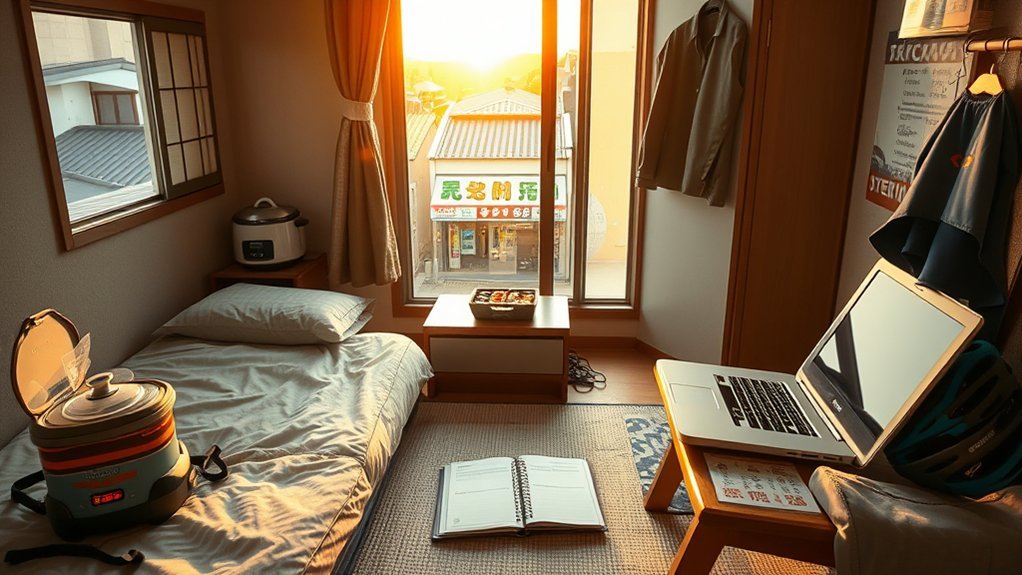
How will you cover living costs in Kyoto while studying and working part-time? Budgeting starts with realistic income-to-expense comparisons: average part-time income for international students in Kinki is ¥56,000/month versus average expenditures of ¥63,000 (¥37,000 accommodation, ¥26,000 meals). That gap shows you’ll likely need additional support or savings.
Use local benchmarks: one-bed city-center rent averages $528 (~¥70–75k) and utilities ≈ $69.20, so your part-time earnings won’t cover central rents. Expatistan’s net salary context (¥286,250/month) implies salary coverage of living costs is about 1.7 months—helpful for planning if you rely on family or scholarships.
Factor taxes: consumption tax (10%, 8% on some items) affects purchases, and income tax is withheld with year-end adjustments by employers. Track fixed costs (rent, utilities) and variable costs (food, transport) separately, and project monthly shortfalls so you can decide on housing location, work hours within visa limits, or financial aid before costs escalate. Additionally, being aware of seasonal demand can help you plan for potential fluctuations in living expenses.
Money-Saving Tips and Local Resources
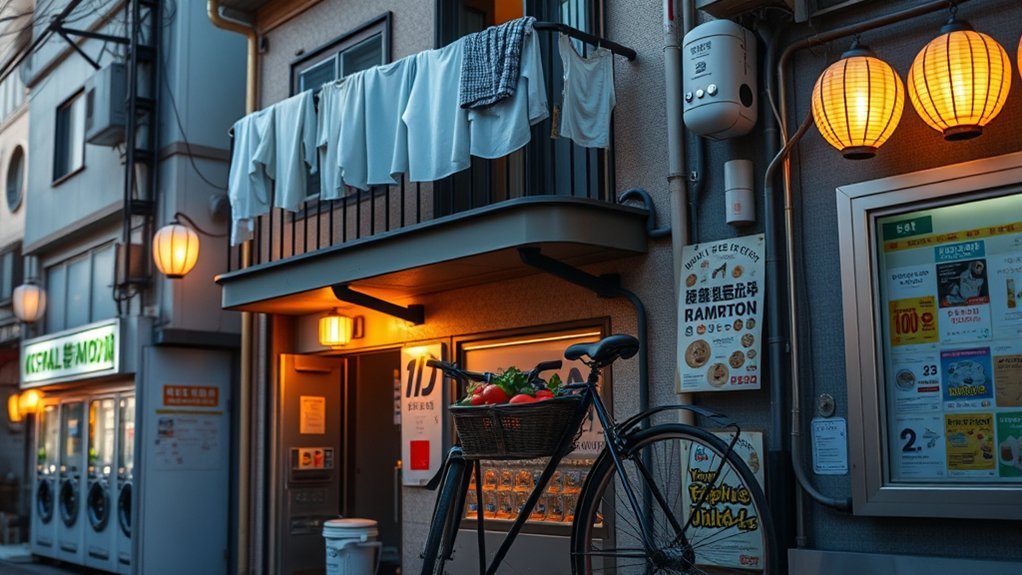
Where can you cut costs without sacrificing safety or convenience? You’ll lower monthly costs by targeting utilities, housing, food, and transport with data-driven choices. Average utilities run ~13,000 yen/month (electricity ~7,000, gas ~3,500); modest conservation shrinks that line quickly.
Where to cut costs without losing comfort? Target utilities, housing, food, and transport with data-driven, practical changes.
Compare rent: 1-bed center ~85,135 yen vs outside ~47,625 yen; moving slightly outward often halves rent impact on total costs. For groceries, use unit prices (milk 263.83 yen/L, bread 254.33 yen/500g, rice 454.47 yen/kg) and favor cheap meals (500–1,000 yen) to project realistic monthly spending.
Transit: single ticket ~235 yen, monthly pass ~12,386 yen—buy passes if you commute daily.
- Choose housing outside center to reduce rent costs dramatically.
- Track and cut utility use to lower the ~13,000 yen monthly bill.
- Shop by unit price and eat cheap meals to control food costs.
- Use monthly transit passes over taxis to optimize transport costs.
Implementing a repair budget for technology maintenance can also help manage unexpected expenses.
Expatistan comparisons help calibrate your overall budget.
Frequently Asked Questions
How Much Is the Average Rent in Kyoto?
The average rent in Kyoto is about ¥85,135 monthly for a 1-bedroom in the city centre and roughly ¥47,625 outside centre; larger 3-bed flats average around ¥266,667, with utilities extra.
How Much Does It Cost to Live in Kyoto Japan?
You’ll spend about $1,188 monthly on average in Kyoto; think of it like a bento box—$528 for city rent, $69 utilities, $69 transit, groceries and extras filling the rest, leaving decent room after a $2,001 median salary.
How Much Money to Live Comfortably in Kyoto?
You’ll need about ¥140,000–160,000 monthly to live comfortably in Kyoto, covering rent, utilities, food, transport and modest leisure; adjust higher for central rent or upscale lifestyle, lower if shared housing or frugal choices.
How Much Is 1 Month Rent in Japan?
Around 50,000–266,667 yen—yes, rents can skyrocket. You’ll typically pay 50k–70k for a small nationwide unit, ~47,600 outside Kyoto center, ~85,135 in Kyoto center, and ~266,667 for a 3-bed city unit.
Conclusion
Living in Kyoto blends predictable costs with local surprises, so plan like a budget-oriented traveler mapping calories on a marathon. Track rent (¥40k–¥100k+), utilities (~¥8k–¥15k), food (¥25k–¥40k), transport (¥10k–¥15k) and connectivity (~¥4k–¥6k). Factor health insurance and leisure. Use part-time income, comb convenience stores and monthly passes to shave expenses. With data as your compass, you’ll steer toward a sustainable, comfortable life in Kyoto.

